
The Trade Desk (TTD)
We’d invest in The Trade Desk. Its rare ability to win market share while pumping out profits is a feature many competitors envy.― StockStory Analyst Team
1. News
2. Summary
Why We Like The Trade Desk
Built as an alternative to "walled garden" advertising ecosystems, The Trade Desk (NASDAQ:TTD) provides a cloud-based platform that helps advertisers and agencies plan, manage, and optimize digital advertising campaigns across multiple channels and devices.
- Well-designed software integrates seamlessly with other workflows, enabling swift payback periods on marketing expenses and customer growth at scale
- Disciplined cost controls and effective management have materialized in a strong operating margin, and it turbocharged its profits by achieving some fixed cost leverage
- Market share has increased as its 23.4% annual revenue growth over the last two years was exceptional


We’re optimistic about The Trade Desk. The valuation looks reasonable based on its quality, so this could be a prudent time to invest in some shares.
Why Is Now The Time To Buy The Trade Desk?
High Quality
Investable
Underperform
Why Is Now The Time To Buy The Trade Desk?
At $38.76 per share, The Trade Desk trades at 6.2x forward price-to-sales. Most software companies are more expensive, so we think The Trade Desk is a good deal when considering its quality characteristics.
By definition, where you buy a stock impacts returns. Compared to entry price, business quality matters much more for long-term market outperformance. Buying in at a great price helps, nevertheless.
3. The Trade Desk (TTD) Research Report: Q3 CY2025 Update
Digital advertising platform The Trade Desk (NASDAQ:TTD) beat Wall Street’s revenue expectations in Q3 CY2025, with sales up 17.7% year on year to $739.4 million. Guidance for next quarter’s revenue was better than expected at $840 million at the midpoint, 1% above analysts’ estimates. Its non-GAAP profit of $0.45 per share was in line with analysts’ consensus estimates.
The Trade Desk (TTD) Q3 CY2025 Highlights:
- Revenue: $739.4 million vs analyst estimates of $719.4 million (17.7% year-on-year growth, 2.8% beat)
- Adjusted EPS: $0.45 vs analyst estimates of $0.44 (in line)
- Adjusted EBITDA: $317.5 million vs analyst estimates of $278.8 million (42.9% margin, 13.9% beat)
- Revenue Guidance for Q4 CY2025 is $840 million at the midpoint, above analyst estimates of $831.6 million
- EBITDA guidance for Q4 CY2025 is $375 million at the midpoint, above analyst estimates of $367.6 million
- Operating Margin: 21.8%, up from 17.3% in the same quarter last year
- Free Cash Flow Margin: 21%, up from 16.8% in the previous quarter
- Market Capitalization: $23.32 billion
Company Overview
Built as an alternative to "walled garden" advertising ecosystems, The Trade Desk (NASDAQ:TTD) provides a cloud-based platform that helps advertisers and agencies plan, manage, and optimize digital advertising campaigns across multiple channels and devices.
The company's self-service platform allows clients to execute advertising campaigns across various formats including connected television (CTV), display, audio, digital-out-of-home, native, and social media. What makes The Trade Desk's technology distinctive is its bid-factor architecture, which enables advertisers to define specific targeting parameters and values, allowing the platform to calculate the worth of ad impressions in real-time and bid only for optimal placements.
For example, a national retailer might use The Trade Desk to target consumers who have previously visited their website with video ads across streaming services, while simultaneously running audio ads on music platforms for users who match their target demographic profile. The platform's data management capabilities let advertisers incorporate both third-party and their own first-party data to refine targeting.
The Trade Desk generates revenue primarily by charging platform fees based on a percentage of clients' advertising spend, rather than through a traditional SaaS subscription model. The company also offers enhanced data services and platform features for additional fees. Its client base consists predominantly of advertising agencies and their clients, with the company maintaining master service agreements that provide ongoing platform access. The Trade Desk has expanded internationally beyond its U.S. origins to serve global advertising needs.
4. Advertising Software
The digital advertising market is large, growing, and becoming more diverse, both in terms of audiences and media. As a result, there is a growing need for software that enables advertisers to use data to automate and optimize ad placements.
The Trade Desk's primary competitors include Google's ad tech solutions, particularly Display & Video 360 (part of Google Marketing Platform), as well as Adobe's advertising cloud. The company also competes with demand-side platforms operated by various ad tech companies.
5. Revenue Growth
A company’s long-term sales performance is one signal of its overall quality. Even a bad business can shine for one or two quarters, but a top-tier one grows for years. Over the last five years, The Trade Desk grew its sales at an impressive 30.7% compounded annual growth rate. Its growth surpassed the average software company and shows its offerings resonate with customers, a great starting point for our analysis.
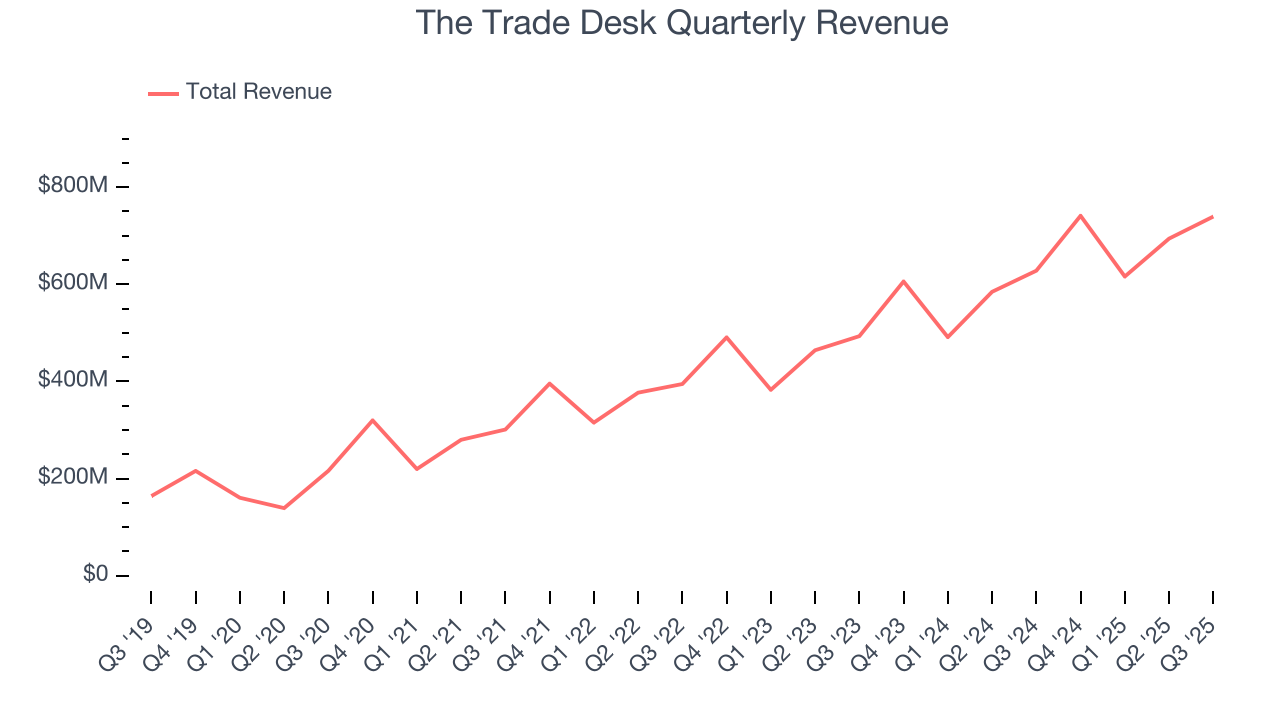
Long-term growth is the most important, but within software, a half-decade historical view may miss new innovations or demand cycles. The Trade Desk’s annualized revenue growth of 23.4% over the last two years is below its five-year trend, but we still think the results suggest healthy demand. 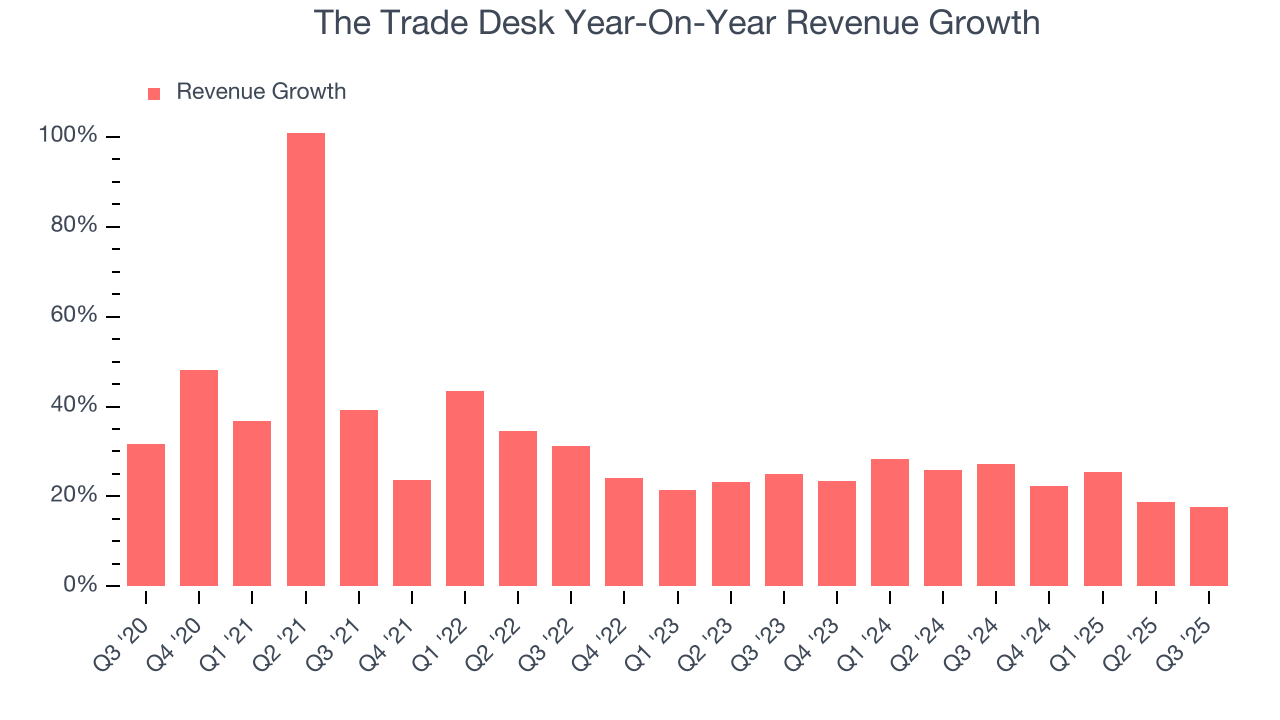
This quarter, The Trade Desk reported year-on-year revenue growth of 17.7%, and its $739.4 million of revenue exceeded Wall Street’s estimates by 2.8%. Company management is currently guiding for a 13.4% year-on-year increase in sales next quarter.
Looking further ahead, sell-side analysts expect revenue to grow 14.1% over the next 12 months, a deceleration versus the last two years. This projection is underwhelming and suggests its products and services will see some demand headwinds. At least the company is tracking well in other measures of financial health.
6. Billings
Billings is a non-GAAP metric that is often called “cash revenue” because it shows how much money the company has collected from customers in a certain period. This is different from revenue, which must be recognized in pieces over the length of a contract.
The Trade Desk’s billings punched in at $3.54 billion in Q3, and over the last four quarters, its growth was impressive as it averaged 20.4% year-on-year increases. This performance aligned with its total sales growth, indicating robust customer demand. The high level of cash collected from customers also enhances liquidity and provides a solid foundation for future investments and growth. 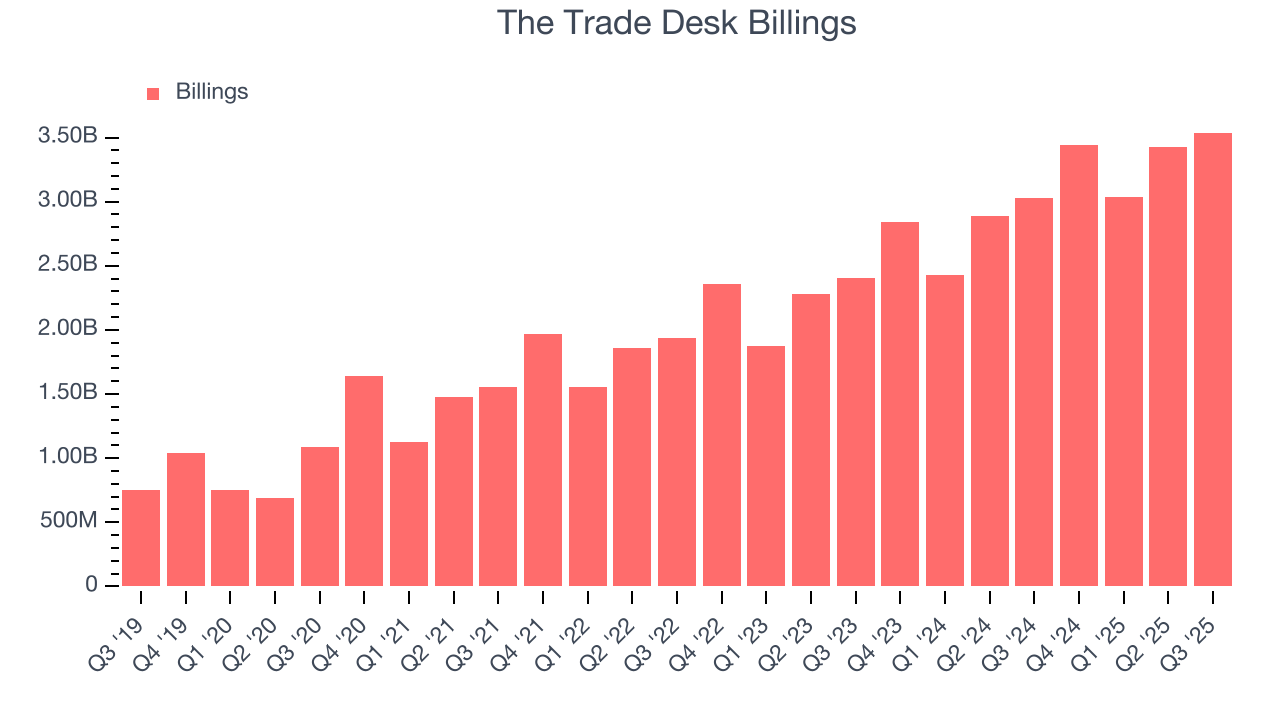
7. Customer Acquisition Efficiency
The customer acquisition cost (CAC) payback period represents the months required to recover the cost of acquiring a new customer. Essentially, it’s the break-even point for sales and marketing investments. A shorter CAC payback period is ideal, as it implies better returns on investment and business scalability.
The Trade Desk is extremely efficient at acquiring new customers, and its CAC payback period checked in at 5.2 months this quarter. The company’s rapid recovery of its customer acquisition costs indicates it has a highly differentiated product offering and a strong brand reputation. These dynamics give The Trade Desk more resources to pursue new product initiatives while maintaining the flexibility to increase its sales and marketing investments.
8. Gross Margin & Pricing Power
What makes the software-as-a-service model so attractive is that once the software is developed, it usually doesn’t cost much to provide it as an ongoing service. These minimal costs can include servers, licenses, and certain personnel.
The Trade Desk’s robust unit economics are better than the broader software industry, an output of its asset-lite business model and pricing power. They also enable the company to fund large investments in new products and sales during periods of rapid growth to achieve higher profits in the future. As you can see below, it averaged an excellent 78.8% gross margin over the last year. That means The Trade Desk only paid its providers $21.19 for every $100 in revenue.
The market not only cares about gross margin levels but also how they change over time because expansion creates firepower for profitability and free cash generation. The Trade Desk has seen gross margins decline by 2.4 percentage points over the last 2 year, which is among the worst in the software space.
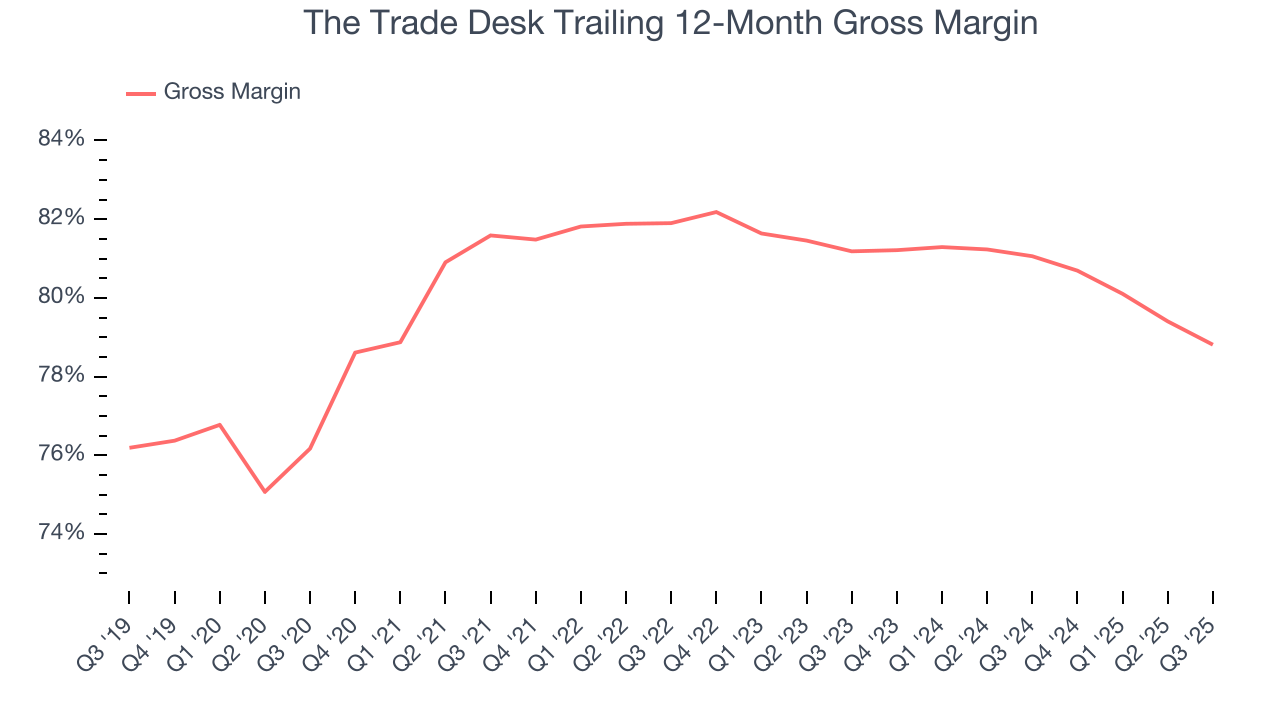
This quarter, The Trade Desk’s gross profit margin was 78.1%, down 2.4 percentage points year on year. The Trade Desk’s full-year margin has also been trending down over the past 12 months, decreasing by 2.2 percentage points. If this move continues, it could suggest a more competitive environment with some pressure to lower prices and higher input costs.
9. Operating Margin
Many software businesses adjust their profits for stock-based compensation (SBC), but we prioritize GAAP operating margin because SBC is a real expense used to attract and retain engineering and sales talent. This metric shows how much revenue remains after accounting for all core expenses – everything from the cost of goods sold to sales and R&D.
The Trade Desk has been a well-oiled machine over the last year. It demonstrated elite profitability for a software business, boasting an average operating margin of 18.9%. This result isn’t surprising as its high gross margin gives it a favorable starting point.
Looking at the trend in its profitability, The Trade Desk’s operating margin rose by 2.6 percentage points over the last two years, as its sales growth gave it operating leverage.
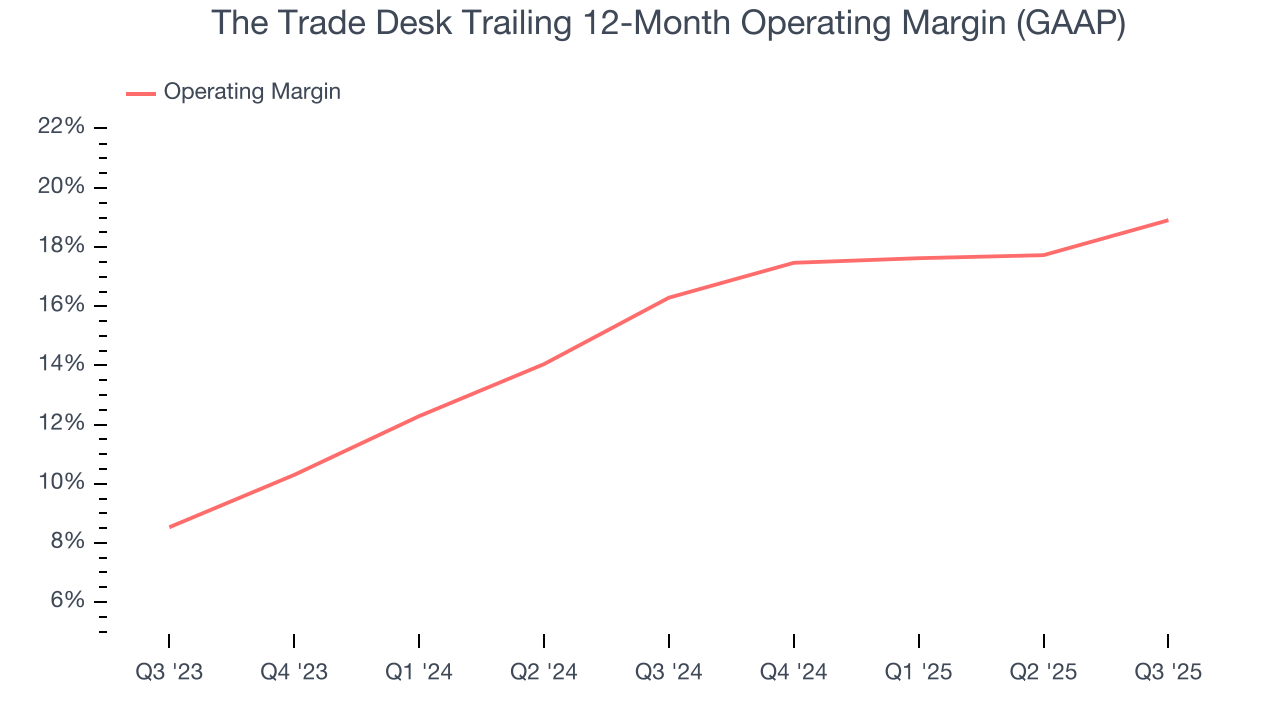
This quarter, The Trade Desk generated an operating margin profit margin of 21.8%, up 4.5 percentage points year on year. The increase was encouraging, and because its gross margin actually decreased, we can assume it was more efficient because its operating expenses like marketing, R&D, and administrative overhead grew slower than its revenue.
10. Cash Is King
If you’ve followed StockStory for a while, you know we emphasize free cash flow. Why, you ask? We believe that in the end, cash is king, and you can’t use accounting profits to pay the bills.
The Trade Desk has shown robust cash profitability, driven by its attractive business model and cost-effective customer acquisition strategy that enable it to invest in new products and services rather than sales and marketing. The company’s free cash flow margin averaged 24.3% over the last year, quite impressive for a software business.
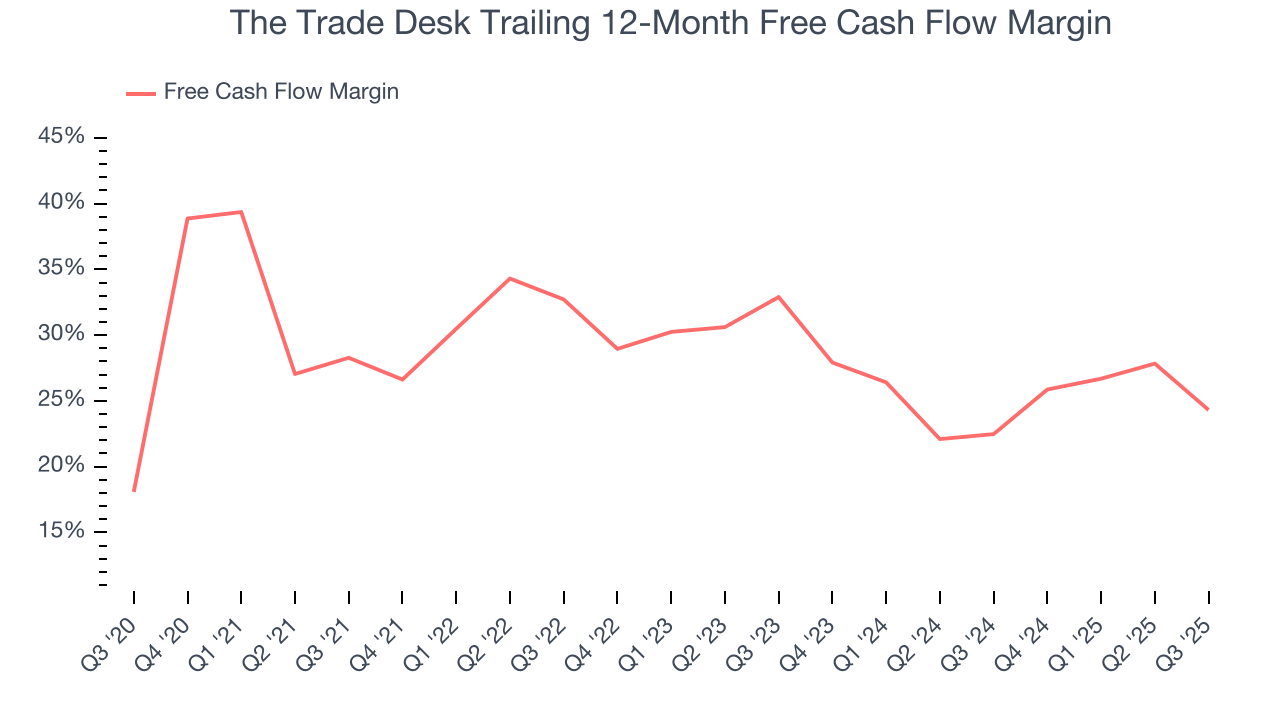
The Trade Desk’s free cash flow clocked in at $155 million in Q3, equivalent to a 21% margin. The company’s cash profitability regressed as it was 14.4 percentage points lower than in the same quarter last year, but we wouldn’t read too much into the short term because investment needs can be seasonal, leading to temporary swings. Long-term trends are more important.
Over the next year, analysts predict The Trade Desk’s cash conversion will improve. Their consensus estimates imply its free cash flow margin of 24.3% for the last 12 months will increase to 28.5%, it options for capital deployment (investments, share buybacks, etc.).
11. Balance Sheet Assessment
Businesses that maintain a cash surplus face reduced bankruptcy risk.
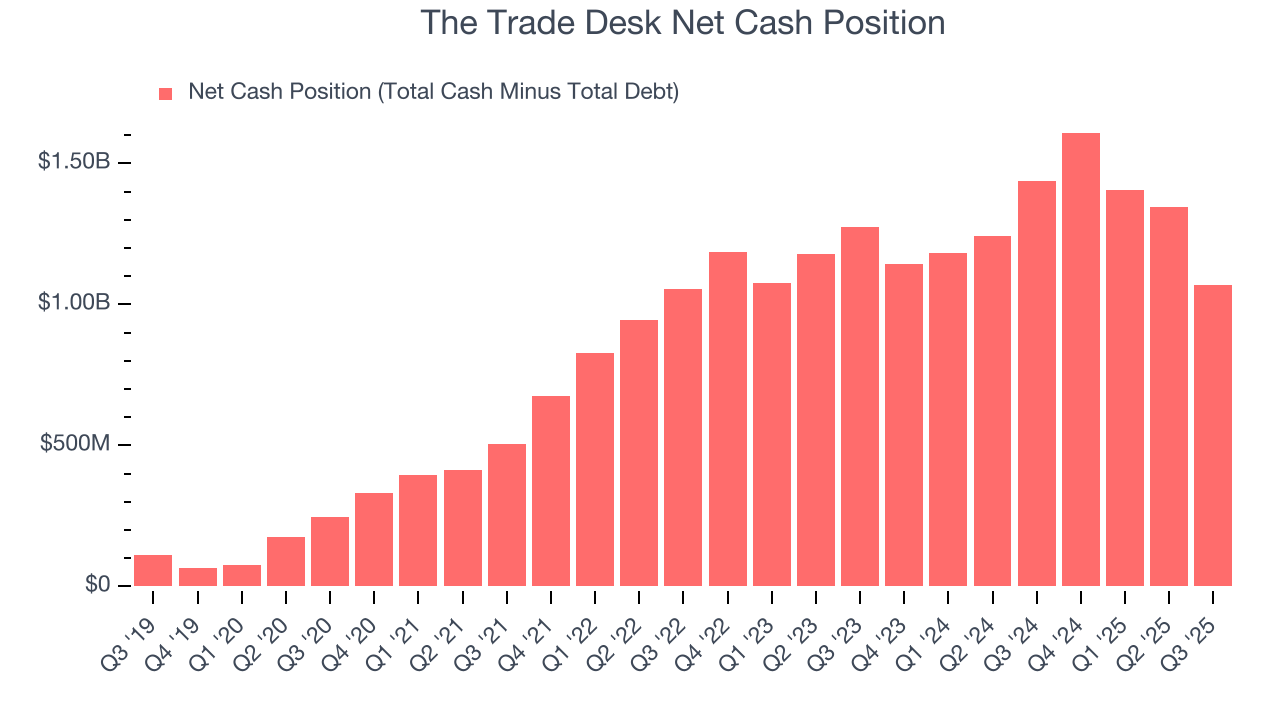
The Trade Desk is a profitable, well-capitalized company with $1.45 billion of cash and $376 million of debt on its balance sheet. This $1.07 billion net cash position is 4.6% of its market cap and gives it the freedom to borrow money, return capital to shareholders, or invest in growth initiatives. Leverage is not an issue here.
12. Key Takeaways from The Trade Desk’s Q3 Results
We were impressed by how significantly The Trade Desk blew past analysts’ revenue and EBITDA expectations this quarter. We were also glad its revenue and EBITDA guidance for next quarter exceeded Wall Street’s estimates. Between July and October, the company repurchased $370 milion of stock, maxing out its share repurchase program, and the board subsequently authorized an additional $500 million of repurchases. A blemish was a sizeable step-up in capital expenditures: in Q1 and Q2, capex collectively clocked in at $110 million; in this quarter alone, that figure hit $70 million. Overall, we think this was a solid quarter with many key metrics above expectations, but investors are likely punishing the company for its capital intensity. Shares traded down 7.4% to $42.48 immediately following the results.
13. Is Now The Time To Buy The Trade Desk?
Updated: December 4, 2025 at 9:15 PM EST
Before making an investment decision, investors should account for The Trade Desk’s business fundamentals and valuation in addition to what happened in the latest quarter.
There are several reasons why we think The Trade Desk is a great business. First of all, the company’s revenue growth was strong over the last five years. And while its expanding operating margin shows it’s becoming more efficient at building and selling its software, its efficient sales strategy allows it to target and onboard new users at scale. On top of that, The Trade Desk’s impressive operating margins show it has a highly efficient business model.
The Trade Desk’s price-to-sales ratio based on the next 12 months is 6x. Looking across the spectrum of software companies today, The Trade Desk’s fundamentals shine bright. We like the stock at this price.
Wall Street analysts have a consensus one-year price target of $62.33 on the company (compared to the current share price of $39.39), implying they see 58.3% upside in buying The Trade Desk in the short term.











